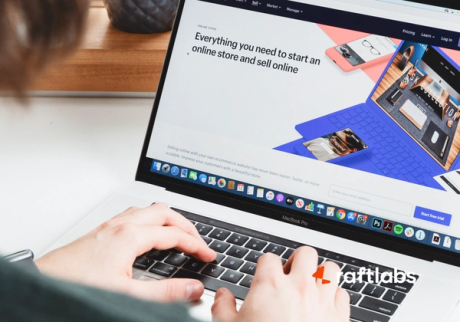Unlocking Success: Best Practices for SaaS Website Design
Introduction:
In the fast-evolving landscape of cloud computing, Software as a Service (SaaS) emerges as a beacon of innovation and efficiency. With a projected growth rate of 17.43% from 2022 to 2030, the SaaS sector is poised to reach a staggering $1,614.10 billion market value. Within this dynamic industry, the design of SaaS websites stands out as a critical determinant of success. As businesses vie for consumer attention in an increasingly competitive market, mastering the art of SaaS website design becomes paramount.
Common SaaS Website Good Design Standards:
Before delving into the intricacies of SaaS website design, it's essential to establish a foundational understanding of common design standards. These standards serve as guiding principles for developers and designers alike, ensuring that websites not only look visually appealing but also function seamlessly.
One fundamental aspect of SaaS website design is the strategic placement of the brand logo. Placing the logo on the left portion of the website aligns with users' natural reading patterns, enhancing brand visibility and recognition. Studies indicate that users spend a significant portion of their time viewing the left side of a website's screen, making this prime real estate for brand representation.
Additionally, the choice of background color plays a crucial role in shaping the user experience. While light backgrounds are generally preferred for their readability and versatility, exceptions exist based on the nature of the SaaS application. For instance, platforms like Netflix, caters to nighttime usage, may opt for dark backgrounds to minimize eye strain and enhance user comfort.
Furthermore, prioritizing mobile-friendliness is imperative in today's digital landscape. With mobile devices accounting for a significant share of internet traffic, ensuring a seamless user experience across various screen sizes and devices is non-negotiable. Technologies like responsive design enable SaaS websites to adapt dynamically to different devices, optimizing accessibility and user engagement.
Lastly, simplicity reigns supreme when it comes to interface design. Embracing a clutter-free layout enhances user comprehension and navigation, fostering a positive browsing experience. Platforms like Airbnb exemplify the power of simplicity, outshining competitors by offering intuitive interfaces that resonate with users.
The Best Practices For SaaS Website Design:
With a solid understanding of common design standards, let's explore the best practices for crafting exceptional SaaS websites that captivate audiences and drive conversions.
Website Structure:
The structure of a SaaS website plays a pivotal role in capturing and retaining audience attention. Gone are the days of lengthy paragraphs and overwhelming text blocks. Instead, modern SaaS companies leverage concise content, visual aids, and strategic placement of CTAs to convey their value proposition effectively.
Take, for example, the cloud-based marketing automation platform, Mailchimp. Renowned for its clutter-free site design, Mailchimp seamlessly integrates visuals with content to deliver a cohesive user experience. By presenting information in bite-sized chunks and complementing it with relevant imagery, Mailchimp effectively communicates its offerings to users, contributing to its expansive user base.
Above-the-Fold Value Proposition:
At the forefront of a SaaS website lies the hero section, where businesses have a golden opportunity to make a compelling first impression. Research indicates that users dedicate a significant portion of their browsing time to the top section of a webpage, underscoring the importance of crafting an impactful above-the-fold value proposition.
While many SaaS pages utilize this prime real estate to showcase product features, a deeper connection with the audience is paramount. As subscription-based services, SaaS companies must strike a balance between conveying product benefits and fostering long-term engagement.
Innovative approaches, such as the one employed by Evernote, exemplify the potential of the hero section. By highlighting deals and elucidating the advantages of their service, Evernote instills confidence in users, assuring them that their notes, tasks, and schedules are seamlessly integrated. Such strategies resonate with the audience and contribute to Evernote's vast user base.
Layout Design:
The layout of a SaaS website serves as its architectural foundation, dictating user flow and engagement. To maximize impact, businesses must prioritize content hierarchy and information dissemination. Wireframing and prototyping emerge as indispensable tools in analyzing and optimizing design choices before website launch.
LambdaTest stands as a testament to effective layout design, boasting a website characterized by simplicity and clarity. With concise content and clear CTAs, LambdaTest guides users effortlessly through its platform, facilitating seamless interaction and comprehension.
Easy Navigation:
Simplicity is key when it comes to website navigation. Regardless of the design elements employed, a website's success hinges on its ease of use. Complex navigation structures can deter users and impede their journey, underscoring the importance of intuitive navigation systems.
Dropbox exemplifies the power of simplicity in navigation, offering users a seamless browsing experience with well-defined categories and clear pathways. By streamlining navigation, Dropbox ensures accessibility and user satisfaction, contributing to its impressive user base.
Simple Sign-Up:
Streamlining the sign-up process is a fundamental principle of website design, particularly for SaaS platforms. In today's fast-paced digital landscape, users crave simplicity and efficiency. Minimizing the number of form fields and offering alternative sign-up methods can significantly enhance user experience and conversion rates.
Jotform sets a stellar example with its user-friendly sign-up alternatives, allowing users to expedite the process by signing up with existing Microsoft or Google accounts. By eliminating barriers to entry, Jotform cultivates a seamless onboarding experience, reflected in its milestone achievement of 1 billion user form submissions.
Conclusion:
In conclusion, the design of SaaS websites is a multifaceted endeavor that requires careful consideration of user experience, functionality, and aesthetics. By adhering to common design standards and implementing best practices, SaaS businesses can create user-friendly and visually appealing websites that resonate with their target audience.
From strategic logo placement to intuitive navigation and streamlined sign-up processes, every aspect of SaaS website design plays a crucial role in shaping user perception and driving conversions. By prioritizing simplicity, clarity, and accessibility, SaaS businesses can differentiate themselves in a crowded market and establish a compelling online presence.
As the SaaS industry continues to evolve, staying abreast of emerging trends and consumer preferences will be essential for maintaining relevance and competitiveness. By embracing innovation and leveraging design principles to enhance user engagement, SaaS businesses can position themselves for sustained success in the digital age.
Frequently Asked Questions
What are the key elements of effective SaaS website design?
Effective SaaS website design incorporates clear navigation, compelling value propositions, mobile responsiveness, and intuitive layouts to enhance user experience and drive conversions.
How can I ensure my SaaS website is user-friendly?
Ensure your SaaS website is user-friendly by prioritizing simplicity, utilizing clear CTAs, optimizing for mobile devices, and providing easy navigation throughout the site.
What role does above-the-fold content play in SaaS website design?
Above-the-fold content on a SaaS website captures users' attention, communicates the value proposition, and encourages further exploration, ultimately driving conversions.
What are some best practices for designing a SaaS landing page?
Best practices for SaaS landing pages include defining a unique selling proposition, using engaging visuals, highlighting benefits over features, and providing social proof to build trust.
How can I optimize my SaaS website for SEO?
Optimize your SaaS website for SEO by conducting keyword research, optimizing meta tags and descriptions, creating high-quality content, improving site speed, and building backlinks from reputable sources.

Riya Thambiraj
Creative content writer at RaftLabs
Insights from our team
Ready to build
something amazing?
With experience in product development across 24+ industries, share your plans,
and let's discuss the way forward.










